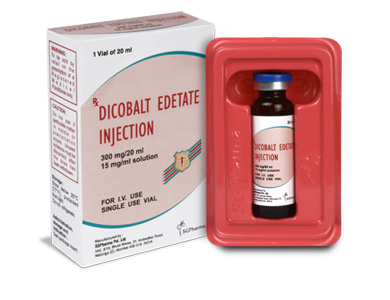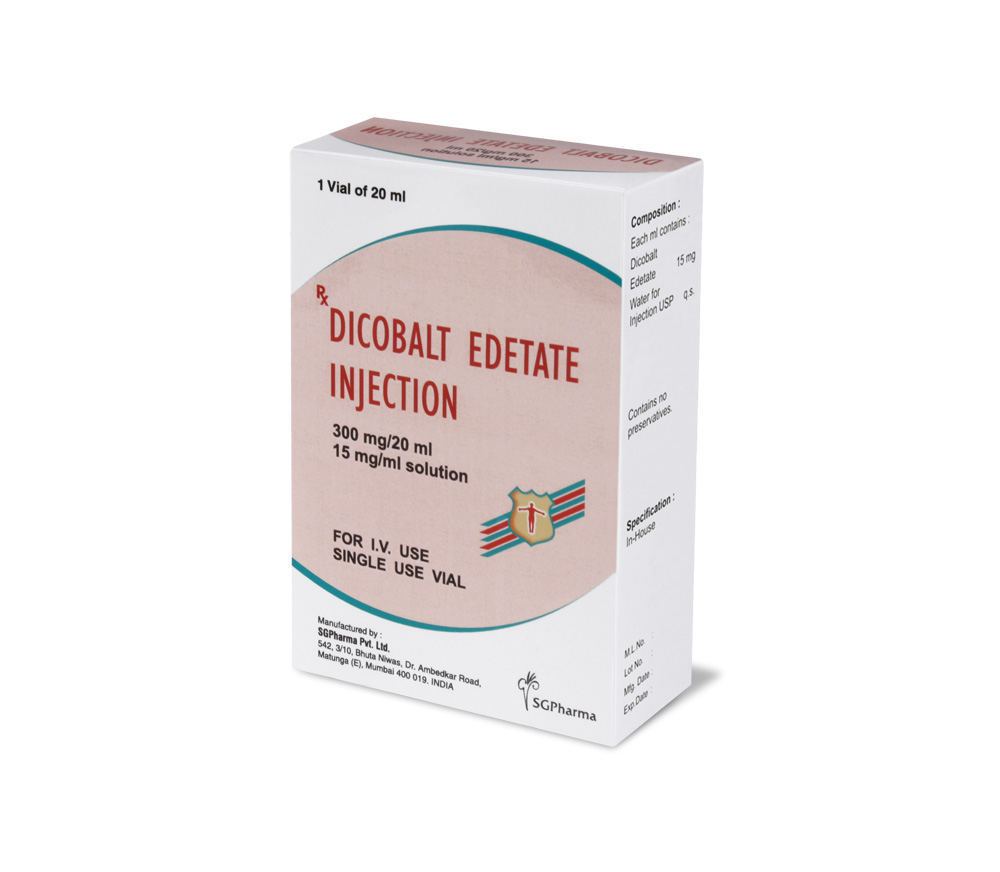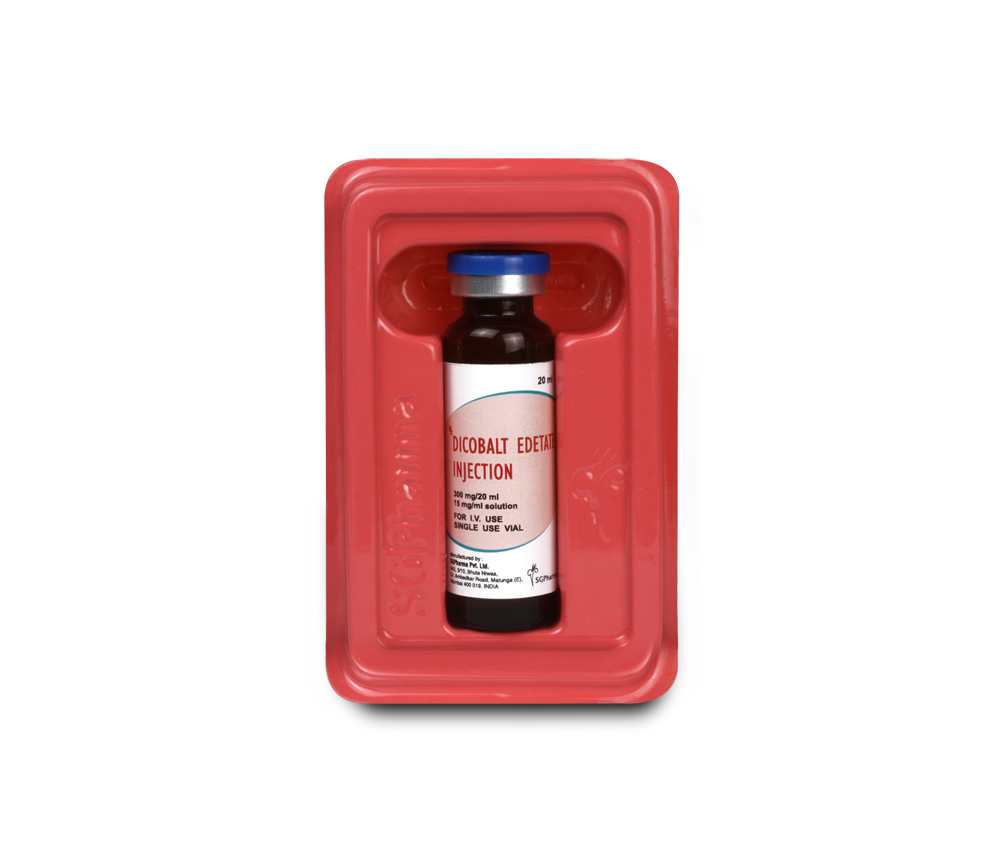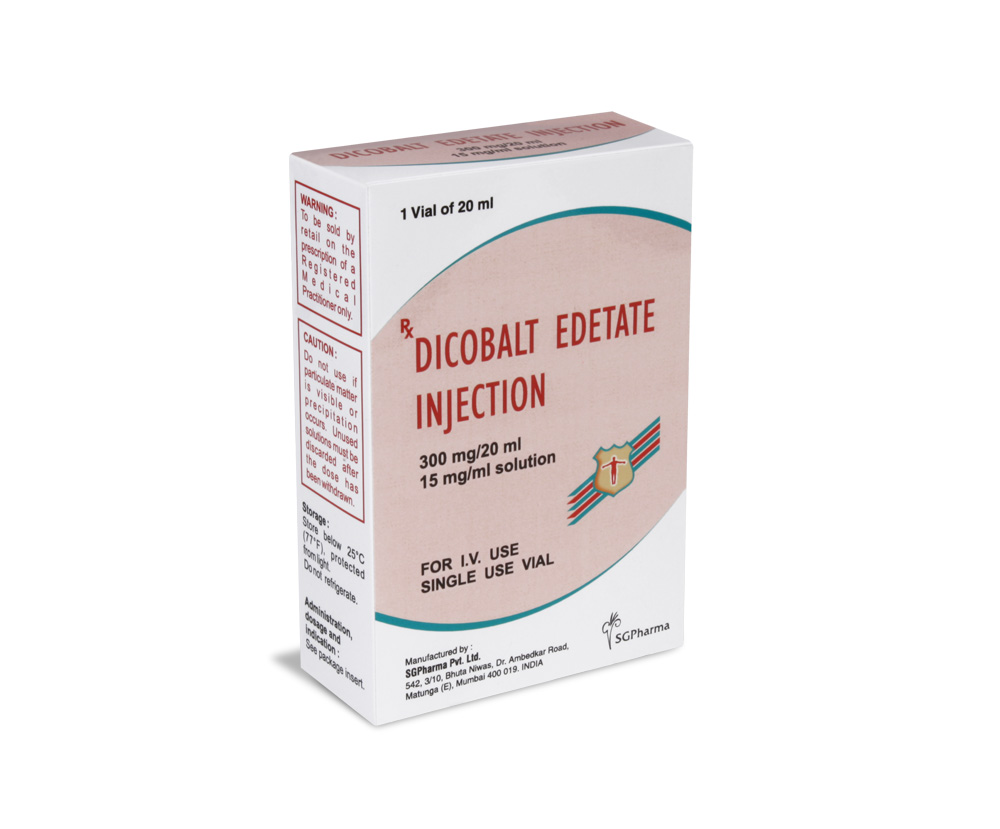
300 mg/20 ml
For the use of a Registered Medical Practitioner or a Hospital or a Institution only.
Dicobalt Edetate Injection (Dicobalt Edetate) is a chelator used in the treatment of acute cyanide poisoning. Chemically Dicobalt Edetate is Cobalt [ethylenediaminetetra-acetato(4-)-N,N´,O,O´]cobalt(II). It’s molecular formula is C10H12CO2N2O8 and molecular weight is 406.1.
Dicobalt Edetate Injection is a rose violet coloured sterile, pyrogen free solution.
COMPOSITION :
Each ml contains :
Dicobalt Edetate 15 mg
Water for Injection USP q.s.
ACTIONS :
Dicobalt Edetate Injection is a specific antidote for acute cyanide poisoning. Cyanide blocks intracellular respiration by binding to cytochrome oxidase. Dicobalt Edetate Injection forms a stable complex with the cyanide and is excreted via urinary route and thereby acting as an antidote.
PHARMACOKINETICS :
Only very limited data are available. Intravenous infusion of Dicobalt Edetate Injection is likely to result in rapid distribution in the extracellular fluid compartment. Excretion is entirely via the kidneys within 24 hours and it is not metabolised.
INDICATIONS :
Dicobalt Edetate Injection is a specific antidote for acute cyanide poisoning. In view of the difficulty of certain diagnosis in emergency situations, it is recommended that Dicobalt Edetate Injection only be given when the patient is tending to lose or has lost consciousness. The product should not be used as a precautionary measure.
Administration :
FOR INTRAVENOUS INJECTION.
Dosage :
Cyanide poisoning must be treated as quickly as possible and intensive supportive measures must be instituted : clear airways and adequate ventilation are essential. 100 % oxygen should be administered concurrently with Dicobalt Edetate.
Adults :
One 300 mg dose intravenously over approximately one minute. If the patient shows inadequate response, a second dose of 300 mg may be given. If there is no response after a further five minutes, a third dose of 300 mg may be administered. Each dose of 300 mg of Dicobalt Edetate Injection may be followed immediately by 50 ml Glucose 50 % intravenously to reduce toxicity. When the patient’s condition is less severe but in the physician‘s judgement still warrants the use of Dicobalt Edetate Injection, the period over which the injection is given should be extended to 5 minutes.
Children :
There is no clinical experience of the use of Dicobalt Edetate Injection in children. As with adults the dose required will be related to the quantity of cyanide ingested.
The elderly :
There is no clinical evidence of the use of Dicobalt Edetate Injection in the elderly, but there is no reason to believe that the dosage schedule should be different from that for adults.
CONTRAINDICATIONS :
Dicobalt Edetate Injection is contraindicated in patients who are hypersensitive to any component of this product.
WARNINGS AND PRECAUTIONS :
There is a reciprocal antidote action between cyanide and cobalt. Thus in the absence of cyanide, Dicobalt Edetate Injection itself is toxic. It is therefore essential that this medicinal product must be restricted to cases of confirmed hydrocyanic poisoning. When the patient is fully conscious, it is unlikely that the extent of poisoning warrants the use of Dicobalt Edetate Injection. This antidote is a complement to intensive-care procedures, which are the real emergency in cyanide poisoning; and its use must not lead to any delay in starting these procedures (ventillation, oxygen therapy, etc.)
No pertinent data or not enough data available. Despite this, Dicobalt Edetate can be prescribed during pregnancy if necessary. Breast feeding should be avoided since not enough data available about the excretion of this medicinal product into the breast milk.
INTERACTIONS AND INCOMPATIBILITIES :
No information available
SIDE EFFECTS :
The initial effects of Dicobalt Edetate Injection are nausea, vomiting, sweating, hypotension and compensatory tachycardia. Other side effects include –
- oedema of the face and neck
- chest pain, cardiac irregularities
- skin rashes

 Cardiovascular
Cardiovascular








